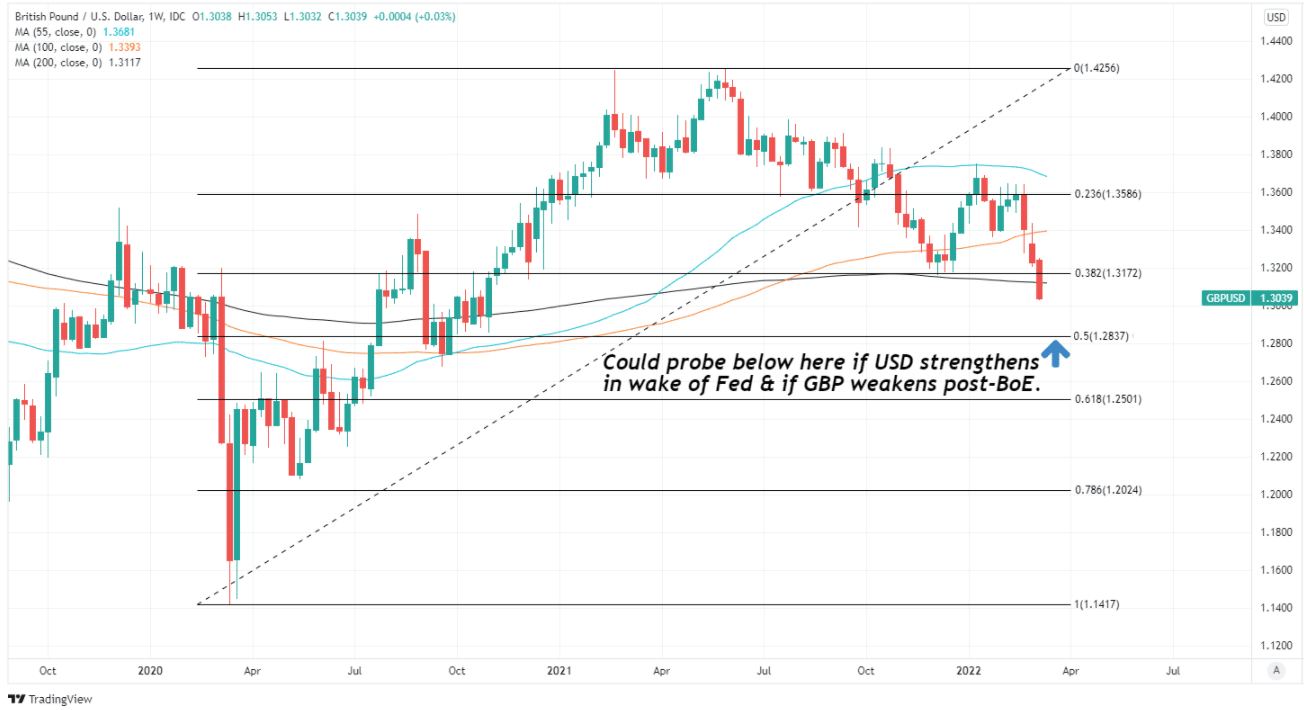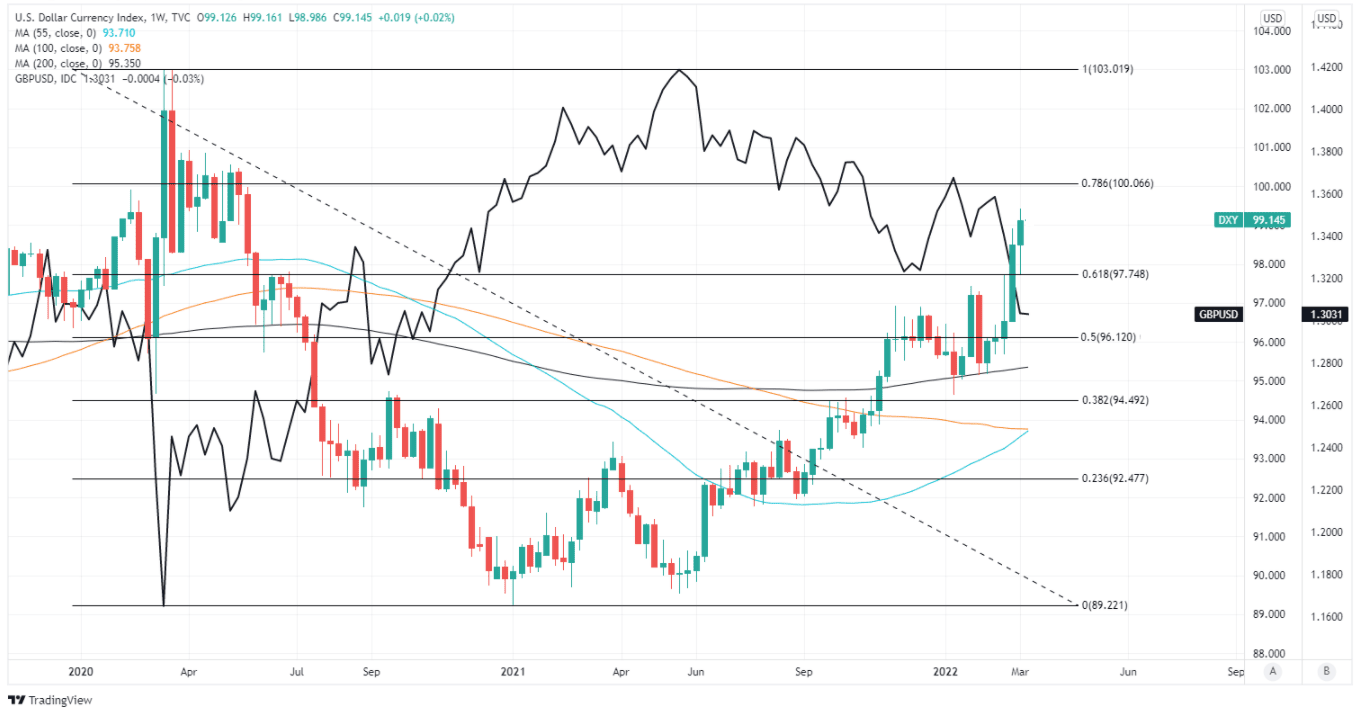Pound / Dollar Week Ahead Forecast: Fed, BoE and Bearish Charts Bring 1.2837 into View
- Written by: James Skinner
-
- GBP/USD vulnerable with Fed, BoE decisions ahead
- Hangs by thread amid bearish breakdown on charts
- USD strength & GBP losses could see 1.2837 tested
- But market response to Fed, BoE commentaries key

Image © Adobe Images
The Pound to Dollar exchange rate ceded major support levels on the charts last week but looming Federal Reserve (Fed) and Bank of England (BoE) monetary policy decisions could yet see it easing further toward 1.2837 or below over the coming days.
Sterling eked out gains over only the safe-haven Japanese Yen and Swiss Franc last week while falling against other major currencies and especially European counterparts that rallied strongly amid speculative suggestions that negotiations would soon end Russia’s ongoing invasion of Ukraine.
“Short squeezes aside, last week markets started to realise how ugly the Ukraine war is for all of us. Expect far more of that this week - and attempts at rallies that get rapidly unwound. History is moving. Markets will be moved too,” warns Michael Every, a global macro strategist at Rabobank.
Despite the bounceback for global markets, Sterling ended the recent week more than one percent lower after the Dollar strengthened following Thursday’s Bureau of Labor Statistics data, which showed U.S. inflation rising to 7.9% in February.
This leaves the Fed squarely in the hot seat ahead of Wednesday’s policy decision and does little to support the Pound-Dollar rate.
"GBP/USD faces the FOMC and Bank of England (BoE) within 24 hours. Both central banks are expected to increase their policy interest rate by 25bp. The market reaction will depend in large part on their post-meeting statements and the FOMC’s press conference," says Joseph Capurso, head of international economics at Commonwealth Bank of Australia, who’s warned that Sterling could fall to 1.2894 this week.
Above: Pound to Dollar exchange rate shown at weekly intervals with Fibonacci retracements of 2020 recovery indicating possible areas of technical support. Includes selected moving-averages. Click image for closer inspection.
- GBP/USD reference rates at publication:
Spot: 1.3022 - High street bank rates (indicative band): 1.2566-1.2657
- Payment specialist rates (indicative band): 1.2905-1.2970
- Find out about specialist rates and service, here
- Set up an exchange rate alert, here
GBP/USD already fell below the 38.2% Fibonacci retracement of its 2020 recovery trend at 1.3172 and its 200-week moving-average at 1.3117 last week, undermining along the way what was the last semblance of meaningful technical support ahead of the 50% Fibonacci retracement located down around 1.2837.
Whether GBP/USD makes it that far down this week likely depends on the U.S. Dollar’s response to Wednesday’s Fed decision and on how Thursday’s BoE policy decision plays out for Sterling.
“In our view, the 2022 dots will likely be mainly clustered around four or five hikes for 2022 (with a few outliers on both ends), given the stronger pace of inflation since the January FOMC meeting,” says Kevin Cummins, chief U.S. economist at Natwest Markets.
Of note, Chairman Jerome Powell indicated earlier in March that this Wednesday is likely to see the Fed lift its interest rate from 0.25% to 0.5%, although last week the financial markets were still pricing-in a high probability of a larger increase to 0.75%.
{wbamp-hide start}
{wbamp-hide end}{wbamp-show start}{wbamp-show end}
While it’s possible that a 0.25% rate rise from the Fed would disappoint some parts of the market and act as a headwind for the Dollar, it’s also likely that the latest dot-plot of forecasts will show Federal Open Market Committee (FOMC) members anticipating a larger number of rate rises for this year than were guided for back in December.
“We like the USD higher, reflecting the concerns that geopolitical tensions are likely to resurface and the Fed will commence liftoff. While that favours both EUR and GBP lower in the very short run, we think the latter is more vulnerable in the current environment,” says Mark McCormick, global head of FX strategy at TD Securities.
It’s also possible there will be downgrades to the Fed’s forecasts for GDP growth, downgrades which are typically supportive of the Dollar even without any accompanying increase in the benchmark Federal Funds interest rate; although in any event the Pound will still have to navigate this Thursday’s decision from the BoE no matter which way Wednesday's Fed event cuts for GBP/USD.
“We favour EUR/GBP drifting a little lower, but remain more worried by GBP/USD. It has failed to recover above previous support levels at 1.3150/3180 and given our strong preference for dollars currently, 1.2850 remains a realistic target near term,” says Francesco Pesole, a strategist at ING.
Above: U.S. Dollar Index at weekly intervals with Fibonacci retracements of 2020 fall indicating possible areas of technical resistance for USD, and shown alongside Pound-Dollar rate. Includes selected moving-averages. Click image for closer inspection.
Secure a retail exchange rate that is between 3-5% stronger than offered by leading banks, learn more.
The BoE is widely expected to lift Bank Rate from 0.5% to 0.75% on Thursday in what would be its third increase since December, but pricing in the overnight-indexed-swap market indicates that investors and traders are anticipating it will rise to 2% by year-end.
This latter point is notable ahead of Thursday’s decision because even before the Russian military began its war on Ukraine in late February, BoE Governor Andrew Bailey had already warned markets “not to get carried away” with their expectations for interest rates later this year.
“A cautious statement would further drag on the GBP for possibly an eventual test of sub-1.30 levels in the days following the decision, particularly as the Fed is expected to deliver a hawkish decision on Wednesday,” says Juan Manuel Herrera, a strategist at Scotiabank.
Since Governor Bailey's February remarks, market expectations for Bank Rate at year-end have risen from 1.8% to 1.99%, implying the BoE would be likely to lift its interest rate at each of the remaining meetings this year.
That demonstrates something of a disregard for everything coming out of the BoE in recent weeks and potentially leaves the market and Sterling poorly positioned ahead of this Thursday's policy decision.
“We think GBPUSD and EURGBP will be sensitive to any meaningful shifts in the outlook for BoE rate hikes. Markets are currently pricing in 5+ hikes over the coming 6m. The worrying growth and inflation backdrop reveals downside risks to that outlook,” TD’s McCormick and colleagues warned in a Friday research briefing.












